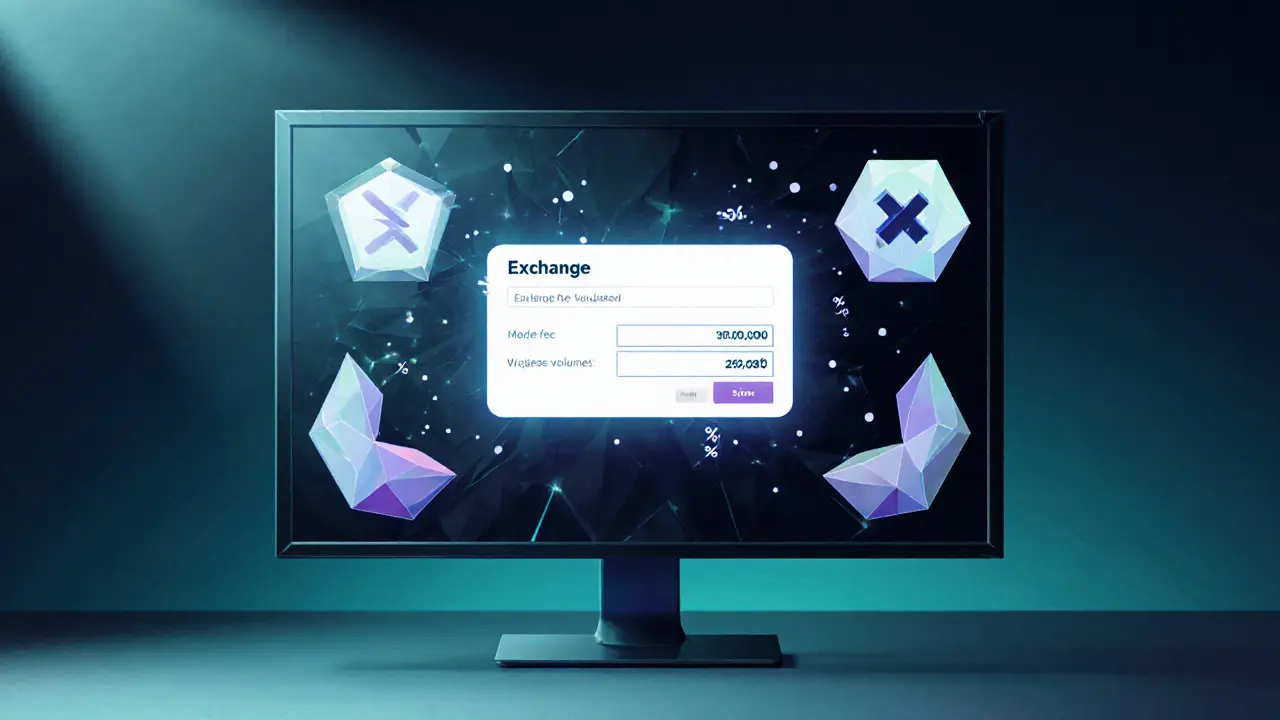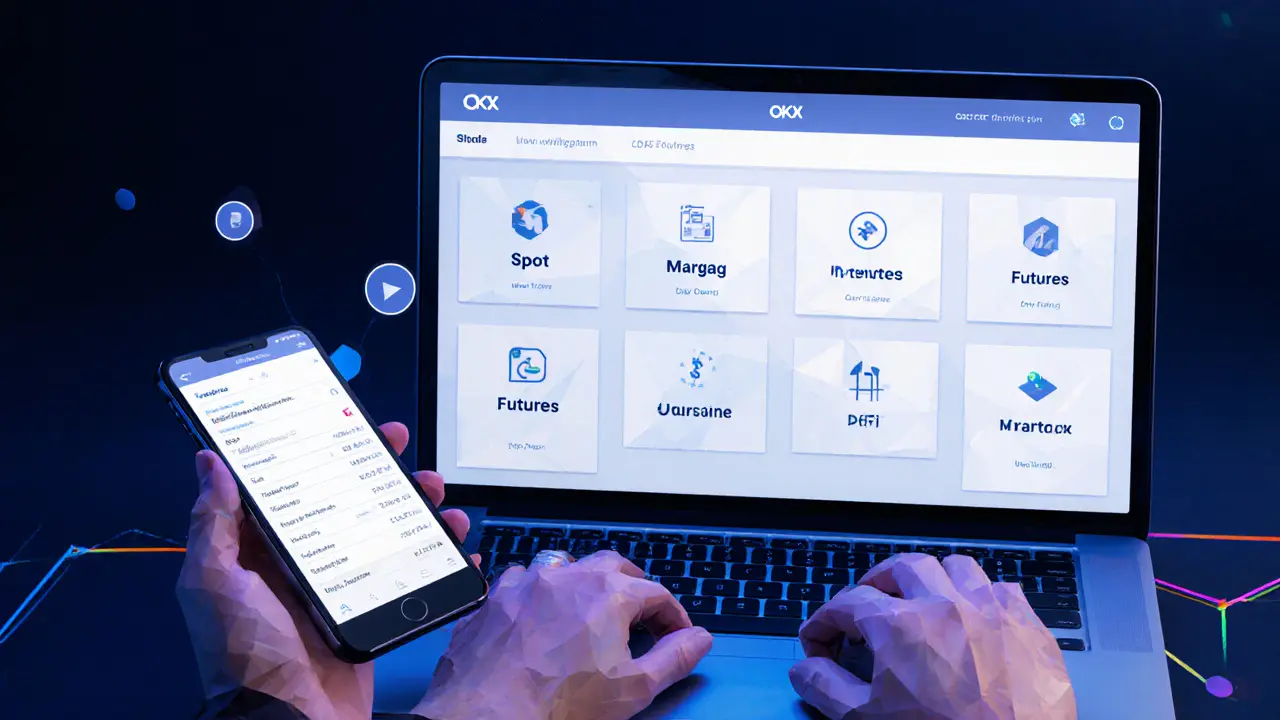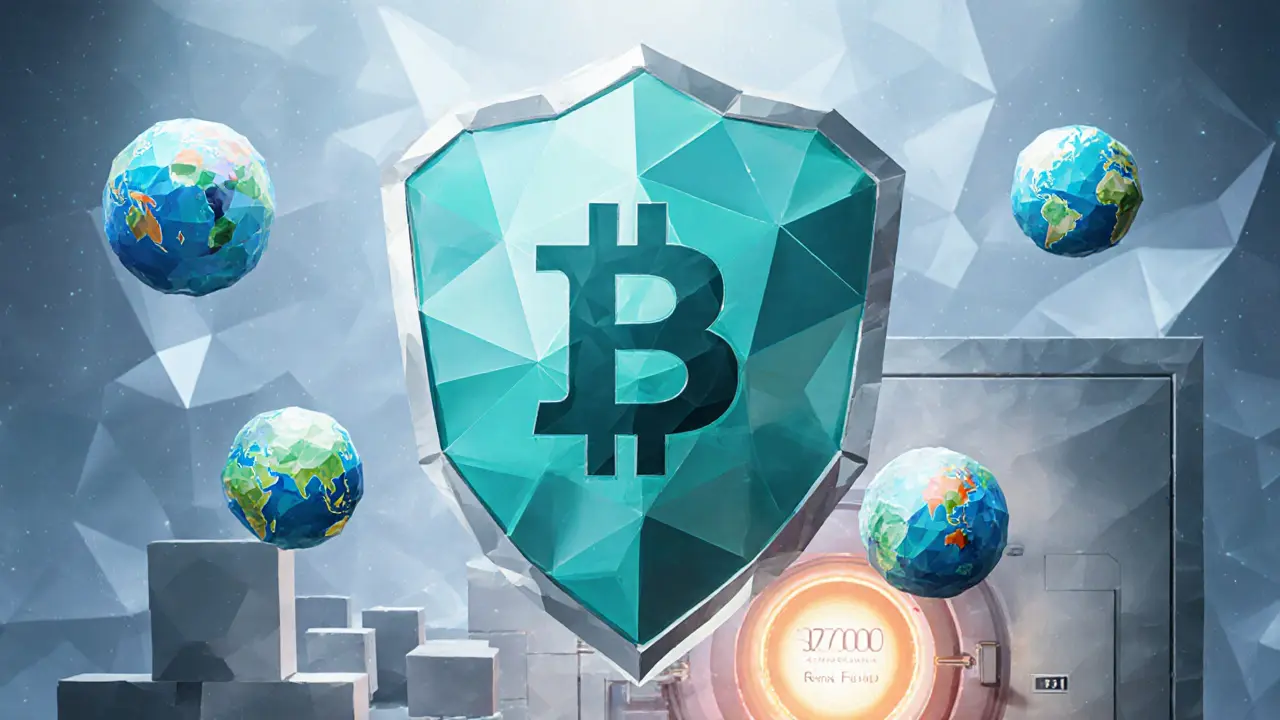OKX Crypto Exchange Review 2025: Fees, Features, Security & How to Start
 Nov, 2 2024
Nov, 2 2024
OKX vs Binance Fee Comparison Calculator
Trading Volume Estimator
Estimate your potential savings by comparing OKX and Binance fees based on your monthly trading volume.
Fee Comparison Results:
Based on a monthly trading volume of $0:
- OKX Spot Trading Fees: 0.08% maker / 0.10% taker
- Binance Spot Trading Fees: 0.10% maker / 0.10% taker
- Potential Monthly Savings with OKX: $0
Recommendation:
Current Fee Structures (2025)
| Exchange | Maker Fee | Taker Fee | Risk Fund |
|---|---|---|---|
| OKX | 0.08% | 0.10% | $700 million |
| Binance | 0.10% | 0.10% | $1 billion (SAFU) |
Note: Fees drop to 0.04%-0.07% for users trading over $10 million/month on OKX.
When evaluating a platform, OKX crypto exchange is a Seychelles‑registered cryptocurrency exchange founded in 2017 that offers spot, margin, futures, options and DeFi services across 400+ assets. In 2025 it ranks as the fourth‑largest exchange by daily volume, handling roughly $1.44 billion every day. If you’re wondering whether OKX is right for you, this review breaks down everything you need - from fee structures and product lineup to security measures, user experience and how to get started.
Key Takeaways
- Low trading fees: 0.08%‑0.10% for standard spot trades.
- Broad product suite - spot, margin, futures, options, staking and DeFi integrations.
- Strong on‑chain security with 2FA, withdrawal safelists and 100% Bitcoin reserve backing.
- Regulatory coverage spans Seychelles, Australia, UAE and several European licences, but the platform is barred in the US, Canada, Japan and a handful of other jurisdictions.
- Mobile apps score 4.4/5 (Android) and 4.6/5 (iOS), praised for clean UI and fast order execution.
Platform Overview
OKX serves more than 100 countries, supports 739 trading pairs and lets users move fiat with nine major currencies (USD, EUR, GBP, AUD, BRL, AED, SGD, CAD, JPY). Deposit minimums are modest - as low as $1 for some fiat routes - while crypto deposits have no lower bound.
Beyond basic spot trading, the exchange offers:
- Spot trading - instant buy/sell of over 350 tokens.
- Margin trading - up to 5× leverage on major pairs.
- Futures contracts - quarterly and perpetual swaps on BTC, ETH and other top assets.
- Options - European‑style contracts for hedging strategies.
- DeFi hub - yield farms, liquidity mining and cross‑chain bridges.
- Automated trading bots and copy‑trading features for hands‑off investors.
Fee Structure and Costs
OKX’s fee schedule is competitive, especially for high‑volume traders.
| Exchange | Maker Fee | Taker Fee | Minimum Deposit | Risk Fund |
|---|---|---|---|---|
| OKX | 0.08% | 0.10% | $1‑$10 (fiat) | $700million |
| Binance | 0.10% | 0.10% | $10 (fiat) | $1billion (SAFU) |
Both makers and takers benefit from volume‑based discounts: users moving over $10million per month see fees dip to 0.04%‑0.07% on OKX.
Security, Regulation & Insurance
Security is a top priority. OKX stores the majority of assets in cold wallets, employs hardware security modules (HSM) for key management, and offers anti‑phishing codes. Two‑factor authentication (2FA) and withdrawal safelists are mandatory for all withdrawals.
On the regulatory front, OKX holds licences in:
- Seychelles (primary regulatory base)
- Australia (AUSTRAC‑registered)
- UAE (virtual asset licence)
- European jurisdictions (MiCA‑aligned licences in the Netherlands and Germany)
While these licences give the exchange operational flexibility, they do not provide the same level of investor protection as the U.S. SEC‑registered firms. The platform’s $700million risk fund is set aside for extreme market events, but it has yet to be tested in a major crisis.

User Experience: Desktop & Mobile
The desktop UI groups the main product areas - Spot, Margin, Futures, Earn - into a left‑hand navigation pane, making it easy to jump between sections. Real‑time charts powered by TradingView provide over 200 technical indicators.
Mobile apps (iOS & Android) mirror the desktop layout and support push notifications for price alerts, order status and security events. Users consistently rate the apps 4.4-4.6 stars, citing fast order execution and smooth onboarding.
Pros & Cons Summary
| Pros | Cons |
|---|---|
| Low fees across all product types | Customer support response times can be slow |
| 400+ tokens and deep DeFi integrations | Limited regulatory protection compared to top‑tier licensed exchanges |
| Robust security (2FA, cold storage, 100% BTC reserve) | Not available in the US, Canada, Japan and several other markets |
| Advanced trading tools - bots, copy‑trading, options | Occasional platform glitches during peak volume periods |
How to Get Started on OKX
- Visit the official site and click “Register.”
- Enter email or mobile number, set a strong password, and confirm the verification code.
- Complete KYC - upload a government ID and a selfie; most users are approved within minutes.
- Enable 2FA via Google Authenticator or Authy.
- Deposit fiat (e.g., AUD via bank transfer) or crypto; deposits typically clear within 2 business days for fiat.
- Navigate to “Spot” and place your first market or limit order.
- Explore the “Earn” tab for staking or the “Bots” section if you prefer automated strategies.
New users can also open a demo account that mirrors live market conditions without risking real funds - a handy way to test futures or options strategies.
OKX vs. Binance: Quick Comparison
| Feature | OKX | Binance |
|---|---|---|
| Daily Trading Volume | $1.44billion | $4.10billion |
| Supported Cryptocurrencies | 400+ | 600+ |
| Base Regulatory Jurisdiction | Seychelles (with AU, UAE licences) | Cayman Islands (global) |
| Spot Trading Fees (Standard) | 0.08% maker / 0.10% taker | 0.10% maker / 0.10% taker |
| Futures & Options | Quarterly & perpetual futures, European options | Perpetual futures, US‑style options |
| Risk Fund | $700million | $1billion (SAFU) |
| Mobile App Rating | 4.4 (Android), 4.6 (iOS) | 4.5 (Android), 4.7 (iOS) |
Both platforms excel in liquidity and tool depth, but OKX edges users who prioritize lower fees and a stronger Bitcoin‑centric reserve backing. Binance remains the leader in sheer asset variety and global market share.

Frequently Asked Questions
Frequently Asked Questions
Is OKX safe for storing large amounts of crypto?
Yes, OKX uses cold‑storage for the majority of assets, offers two‑factor authentication, withdrawal whitelists and a 100% reserve backing for Bitcoin. However, unlike some US‑regulated platforms, it does not provide FDIC‑type insurance, so users should consider a hardware wallet for long‑term holdings.
What are the deposit limits for fiat on OKX?
Deposit limits vary by currency and verification tier. Unverified accounts can deposit up to $2,000 per day, while fully verified users enjoy unlimited deposits. Minimums start at $1 for most fiat methods.
Can I trade futures on OKX without a margin account?
Futures trading on OKX requires a separate Futures wallet but does not need a traditional margin account. You simply transfer assets into the Futures wallet and choose the desired leverage.
How does OKX’s risk fund work?
The $700million risk fund is earmarked to cover extreme market events or security breaches. In theory, if a large loss occurs that exceeds user collateral, the fund steps in to reimburse affected traders. The fund has not yet been deployed in a real‑world incident.
Why is OKX unavailable in the United States?
US regulators require stringent licensing and custody standards that OKX has not pursued. Consequently, the platform blocks IP addresses from the US and Canadian territories to stay compliant with local law.


Karl Livingston
November 2, 2024 AT 04:18I’ve been dabbling in spot and futures on OKX for a few months now, and the fee split between makers and takers feels pretty competitive compared to other midsize exchanges. The UI on the desktop makes it easy to hop between Spot, Margin, and Futures without opening new windows, which saves a lot of clicks. One thing I appreciate is the low $1 fiat deposit floor – it lets newcomers test the waters without a big upfront commitment. The 2FA and withdrawal whitelist add an extra safety layer that I think is essential nowadays. Overall, it’s a solid platform for someone looking to expand beyond just spot trading.
Kyle Hidding
November 4, 2024 AT 04:18From a risk-adjusted throughput perspective, OKX’s tiered fee architecture leverages volume elasticity to optimize cost‑of‑capital for high‑frequency arbitrageurs. Their latency‑reduction stack, while not as cutting‑edge as proprietary matching engines, still achieves sub‑millisecond order placement, which is crucial for scalpers. However, the missing API sandbox for complex option strategies introduces friction for systematic traders.
Andrea Tan
November 6, 2024 AT 04:18Just started using the OKX mobile app and I’m impressed by how smooth it feels. The push notifications for price alerts helped me catch a dip I would have missed on desktop. It’s also nice that the app mirrors the same trading pairs you see on the website, so there’s no need to learn a new layout.
meredith farmer
November 8, 2024 AT 04:18Leaving the app for a moment, I dug into the risk fund details and found the $700 million figure a bit nebulous – they don’t disclose how it’s allocated across different market stress scenarios. It’s reassuring that most of the assets sit in cold storage, but the lack of a transparent insurance policy still gives me pause.
Peter Johansson
November 10, 2024 AT 04:18Hey folks, if you’re thinking about transitioning from a smaller exchange, consider the educational resources OKX offers. Their tutorials on futures margin requirements and options Greeks are surprisingly thorough for a platform that’s still expanding its brand globally. Also, the community chat rooms (though not heavily moderated) can be a good place to pick up trading tips.
Cindy Hernandez
November 12, 2024 AT 04:18Adding to that, the Earn section has a few stable‑coin staking products that pay around 4‑5 % APY, which is competitive given the current market rates. Just remember the lock‑up periods; you can’t pull out instantly without a penalty.
Christina Norberto
November 14, 2024 AT 04:18While OKX’s fee schedule appears attractive, regulators in the US and Canada have flagged the exchange for operating without a proper license. This geopolitical risk could affect liquidity if a crackdown were to happen, so keep an eye on any official statements from their compliance team.
Fiona Chow
November 16, 2024 AT 04:18Sure, the regulatory gray‑area is a concern, but honestly, most traders I know already use a VPN and are comfortable with the risk. The platform’s performance during peak market spikes has been solid, so the trade‑off might be worth it for the lower fees.
Rebecca Stowe
November 18, 2024 AT 04:18Looks promising!
Aditya Raj Gontia
November 20, 2024 AT 04:18From a purely technical standpoint, the latency on OKX’s WebSocket streams can occasionally lag behind Binance during extreme volatility, which might affect algorithmic strategies that rely on sub‑second data.
Kailey Shelton
November 22, 2024 AT 04:18I tried the demo account for futures, and it mirrors the live market pretty closely. It’s a safe sandbox for testing leverage tactics before committing real capital, which is something I wish more exchanges would provide.
Angela Yeager
November 24, 2024 AT 04:18Definitely a good practice. Just remember that the demo doesn’t simulate slippage the way a real order book does, so you might see slightly better fills in the sandbox.
vipin kumar
November 26, 2024 AT 04:18When you examine OKX’s ecosystem from a macro‑level, several interlocking components emerge that collectively shape its market positioning. First, the fee differentiation between makers and takers incentivizes liquidity provision, which in turn stabilizes order book depth during volatile sessions. Second, the integration of DeFi bridges expands asset accessibility, allowing users to move tokens across chains without leaving the platform’s interface. Third, the risk fund, while not as sizable as Binance’s SAFU, still provides a buffer against systemic shocks, reinforcing confidence among institutional participants. Fourth, regulatory licenses in multiple jurisdictions-Seychelles, Australia, UAE, and select EU states-grant OKX a degree of legitimacy, even if they fall short of the rigorous standards required in North America. Fifth, the availability of advanced trading instruments such as options and perpetual futures attracts sophisticated traders seeking hedging mechanisms. Sixth, the comprehensive educational resources, ranging from basic tutorials to deep dives on Greeks, lower the barrier to entry for newcomers, thereby expanding the user base organically. Seventh, the platform’s API suite, though lacking a dedicated sandbox for complex strategies, still offers sufficient endpoint coverage for most algorithmic applications. Eighth, the mobile app’s high rating reflects a user‑centric design philosophy that prioritizes speed and reliability, crucial for on‑the‑go trading. Ninth, the partnership network with liquidity providers ensures competitive spreads, which is a subtle yet vital factor for cost‑sensitive traders. Tenth, the ongoing development roadmap, which includes planned enhancements to the order matching engine, signals a commitment to performance optimization. Eleventh, community engagement through chat rooms and social channels fosters a sense of belonging, albeit with the risk of misinformation. Twelfth, the presence of a demo environment for futures allows risk‑averse users to experiment safely. Thirteenth, the staking and Earn products generate passive yield, diversifying revenue streams for users. Fourteenth, OKX’s support for fiat on‑ramps in nine major currencies eases the onboarding process for global participants. Finally, the platform’s occasional technical glitches during peak traffic underscore the importance of robust infrastructure scaling. All these elements together paint a picture of a rapidly evolving exchange that balances growth ambitions with operational challenges.
kishan kumar
November 28, 2024 AT 04:18While the exhaustive list you provided is thorough, it also hints at a certain over‑engineering that may not translate into tangible user benefits. Excessive feature bloat can distract from core stability, especially if updates are not rigorously tested.
Anthony R
November 30, 2024 AT 04:18Thanks for the balanced overview!
Vaishnavi Singh
December 2, 2024 AT 04:18I find the philosophical angle of trading platforms intriguing; they’re not just tools but extensions of our risk perception. When a user steps onto OKX, they’re entering a curated micro‑economy where fee structures act as subtle nudges toward particular trading behaviors. The platform’s emphasis on lower maker fees could be seen as an invitation to provide liquidity, aligning the user's incentives with the exchange's health. Yet, the hidden costs-such as withdrawal fees on certain chains-remain an opaque variable that many overlook. From an epistemological standpoint, the transparency of risk funds versus the opacity of internal governance decisions creates a paradox: users are asked to trust a system whose inner workings are partially concealed. Moreover, the cross‑border regulatory mosaic, while expanding market access, also introduces jurisdictional ambiguities that can affect user rights in dispute scenarios. The availability of sophisticated instruments like options democratizes advanced strategies but also raises the bar for required financial literacy. In essence, the decision to trade on OKX is a trade‑off between accessibility, cost efficiency, and the degree of institutional oversight one is comfortable with.